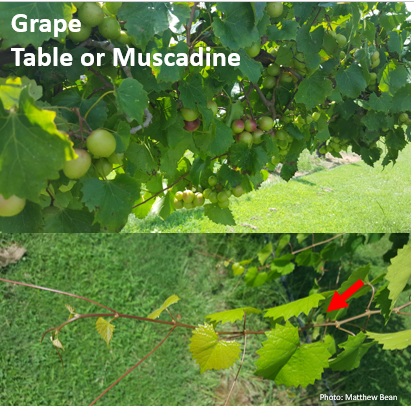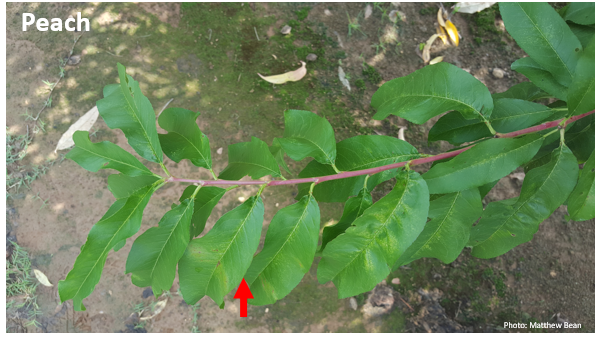
Plant Tissue Nutrient Sampling For Small Fruit and Tree Fruit in Arkansas
Every year you probably apply fertilizer to your orchard fields. But how much of those nutrients in the soil make it into the plant? Are you over-applying fertilizer or not applying enough? How can you tell? Nutrient deficiencies (too little) and toxicities (too much) may show up in leaf color, plant performance or crop yields.
For example,
Too little Nitrogen may result in:
- Low amount of new growth, low vigor
- Chlorosis of old leaves
- Small fruit size and low yield
Too much Nitrogen may result in:
- Long length between nodes (internode length) -> lower yield per shoot or limb
- Reduced fruit firmness- shorter shelf life
- High risk for disease
- Nitrogen applied too late in the season -> plants don’t acclimate and greater risk of winter injury
However sometimes nutrient deficiencies may not exhibit obvious signs despite that
reductions to crop yields are occurring. Today I want to discuss a tool that should
be used every 1-2 years to monitor crop nutritional status and improve fertilizer
use efficiency to help you waste less money on fertilizer and improve crop yield potential.
What?
Plant tissue nutrient sampling or foliar nutrient sampling is an easy way to test to see what nutrients are stored in the leaves or stems of the plants. Basically leaves or stems( petioles) are taken from the plant sent to a lab for chemical analysis and results are returned on the amounts of major nutrients (i.e. Nitrogen, potassium, phosphorus, calcium, etc.) that are held in the leaves. Research has established that certain levels of nutrients must be held in the leaves of a plant at a certain stage of its lifecycle in order for the crop to maximize its yield potential. The optimum levels and the time when the plant tissue nutrient sample should be taken (after bloom, during fruit sizing, after harvest, etc.) vary by crop.
These established critical ranges for nutrients of different crops at a specific stage in the crop’s yearly lifecycle is a key part of using this research to fine tune your fertilizer application rates.
Plant tissue nutrient levels naturally fluctuate greatly both up and down through
the year. For this reason pulling plant tissue nutrient samples must be done at the
right stage of the crop’s lifecycle in order to compare the results to established
recommended ranges.
When?
Mid-summer is one time of the year when it is appropriate to take plant tissue nutrient samples for several crops, these include:
Apple and Pear: Mid-season (8-10 weeks after bloom), sample mature leaves from the mid-portion or near the base of the current season’s terminal growth.
Blackberry: Floricane fruiting varieties Mid- to late July (after harvest).
- Primocane fruiting varieties Late July to August (at green to red fruit stage).
Blueberry: In the first several weeks after harvest, sample lateral shoots (for both southern highbush and rabbiteye)
Grape - Bunch (table, Wine, juice):
- 1st sample option: full bloom (May-June), collect petioles from opposite flower clusters. Separate the petioles from the leaves and submit the petioles.This sampling time allows for amending the fertilizer program for the current season.
- 2nd sample option: Collect petioles in mid to late summer around verasion (fruit softens and changes color) from leaves opposite fruit clusters. Separate the petioles from the leaves and submit the petioles. This sampling time allows for amending the fertilizer program for the NEXT season.
Grape- Muscadine: Collect leaves opposite from fruit clusters in mid to late summer before final fruit swell (August). Only submit leaves.
Peach: Mid-season (July or August), sample mature leaves from the mid-portion or near the base of the current season’s terminal growth
Pecan: Early July to early august. Collect leaf pairs opposite each other.
- Samples that are being pulled after the harvest is over or late in the season, are
used to amend fertilizer practices for the following spring. (Fertilizer should not
be applied after early August for most fruit crops.) Samples pulled during the cropping
cycle may be used to amend micronutrient fertilization practices for the current season
but are primarily useful to plan for the next season. Once fruit is set and filling
out fertilization practices can have only minimal impacts on current season yields
Where?
In order to get an accurate interpretation of the results from plant tissue nutrient sampling it is important to sample leaves of the correct age and from the correct part of the plant. The correct age of leaf to sample from the plant is the Most Recently Mature Leaf (MRML). This means not the newest tender leaves that are still opening and not the older leaves that are starting to age but the leaves that recently became of mature size and color. Generally these are leave 4-5 leaves back from the growing point of the plant. For most crops you will collect the leaves and the attached petioles. However in some cases you will need to detach the petiole from the leaf.
This means that on Blackberry you should sample leaves only off of primocanes for both floricane and primocane fruiting varieties. On trees sample leaves that receive sunlight and are not on inner branches. In all cases avoid leaves that show signs of disease or damage.
I will attach some pictures below to show what this looks like for different crops.





How?
Collect leaves or petioles(1-2 per plant) from 20-40 healthy plants within a uniform area. Until you have at least 50 leaves. For bunch grapes you will want closer to 100 petioles. The more plants you pull leaves from the more accurate of a result you will get.
Be sure to collect separate samples from areas of different variety, soil type, planting date or management history.
Wipe down the leaves with a damp paper towel to remove dirt. This step is very important
if you have applied any foliar fertilizers recently that may still be on the outside
of the leaf. Wipe the leaves again with dry paper towels to remove excess moisture.
Place the leaves in dry paper towels and a paper bag. Do not place in plastic bags.
We suggest pulling the sample on a Sunday or Monday morning and taking the sample
immediately to your county agent so that is gets to the lab in the middle of the week
and not over a weekend. Find your local county agent here, they can help you mail in the sample. The cost is $20 per sample. They will use
this form (AGR 423). You should receive your results back from the lab in 3-5 days on average.
Why?
There are two main reasons to collect plant tissue nutrient samples.
Predictive
This is much like going to the doctor for a yearly check-up and will help diagnose nutrient issues early, before they show up as a loss of yield.
- To estimate fertilizer rates for the following year
- Detect issues before they appear
- Send a sample from normal or average plants at the prescribed time of the year.
Diagnostic
This is like going to the doctor when you are sick and showing symptoms. Sending a plant tissue nutrient sample when you see symptoms of deficiency or toxicity will help diagnose these issues once they are occurring.
- There is a problem
- Can be done any time of year
- Send both normal and non-normal samples together to compare
For more Information here is a factsheet on Plant tissue Nutrient Sampling.
A note on Soil Sampling
Plant tissue nutrient sampling should be paired with regular soil sampling. Together the two samples provide good information to monitor what is going on in the nutrients stored in your soil and plants. Soil sampling provides an additional critical piece of information on soil pH. Soil pH determines how available nutrients are in the soil for plants to take up. Very often if a nutrient imbalance is detected in the leaves of a plant we will need to know what the soil pH is in order to determine if soil acidity is the root cause of the issue. Acidic soil pH is one of the biggest limiters to crop production throughout the Southeastern US. Liming can help reduce this limitation to crop production, but lime takes several months to change the soil pH. For this reason late summer or early fall is a good time to pull soil samples so you have time to put out lime if it is needed well in advance of the spring season.
Annual soil sampling is particularly important where sulfur and/or copper are applied for disease control.